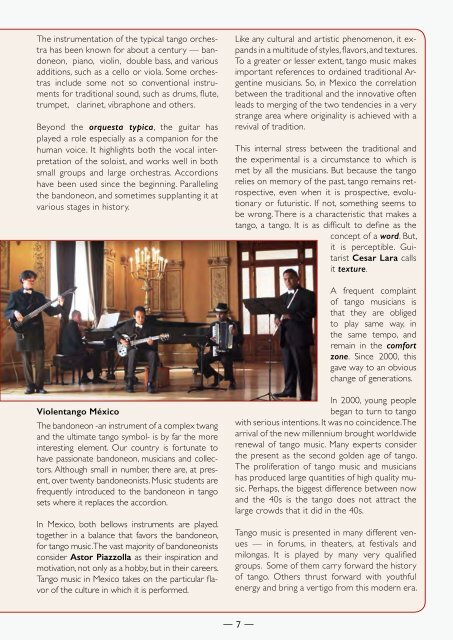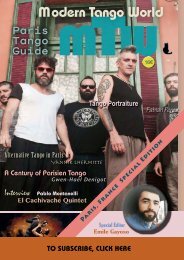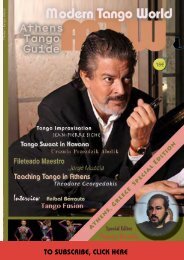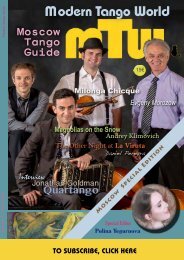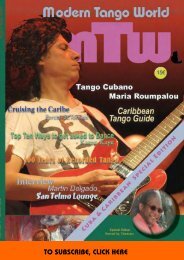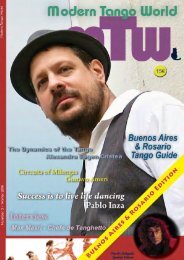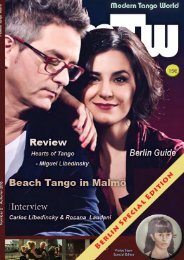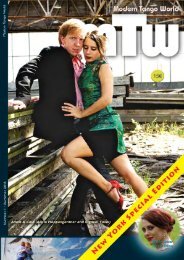Modern Tango World #5 (Mexico)
Mexico Special Features Milongas in the Park Roberto González 3 Snapshot of the Mexican Music Scene Miguel Garcia 6 A New Generation Mauricio Salvador 12 Guide to Tango in Mexico 16 Visual Tango Poems Murat Erdemsel 22 Interview with Plaza Francia Marco Buso 26 Tango Therapy Around the World 30 Movie Review: Tango Pasion Alexandru Eugen Cristea 33 New Tango Music Arndt Büssing 34 Horacio Salgan: Tango Giant 38 DJ/VJ-ing - A VJ Manifesto Zarah Cabanas 40 Tango Moves: caminando Raymond Lauzzana 44 Letters to the Editor 47
Mexico Special Features
Milongas in the Park Roberto González 3
Snapshot of the Mexican Music Scene Miguel Garcia 6
A New Generation Mauricio Salvador 12
Guide to Tango in Mexico 16
Visual Tango Poems Murat Erdemsel 22
Interview with Plaza Francia Marco Buso 26
Tango Therapy Around the World 30
Movie Review: Tango Pasion Alexandru Eugen Cristea 33
New Tango Music Arndt Büssing 34
Horacio Salgan: Tango Giant 38
DJ/VJ-ing - A VJ Manifesto Zarah Cabanas 40
Tango Moves: caminando Raymond Lauzzana 44
Letters to the Editor 47
Create successful ePaper yourself
Turn your PDF publications into a flip-book with our unique Google optimized e-Paper software.
The instrumentation of the typical tango orchestra<br />
has been known for about a century — bandoneon,<br />
piano, violin, double bass, and various<br />
additions, such as a cello or viola. Some orchestras<br />
include some not so conventional instruments<br />
for traditional sound, such as drums, flute,<br />
trumpet, clarinet, vibraphone and others.<br />
Beyond the orquesta typica, the guitar has<br />
played a role especially as a companion for the<br />
human voice. It highlights both the vocal interpretation<br />
of the soloist, and works well in both<br />
small groups and large orchestras. Accordions<br />
have been used since the beginning. Paralleling<br />
the bandoneon, and sometimes supplanting it at<br />
various stages in history.<br />
Like any cultural and artistic phenomenon, it expands<br />
in a multitude of styles, flavors, and textures.<br />
To a greater or lesser extent, tango music makes<br />
important references to ordained traditional Argentine<br />
musicians. So, in <strong>Mexico</strong> the correlation<br />
between the traditional and the innovative often<br />
leads to merging of the two tendencies in a very<br />
strange area where originality is achieved with a<br />
revival of tradition.<br />
This internal stress between the traditional and<br />
the experimental is a circumstance to which is<br />
met by all the musicians. But because the tango<br />
relies on memory of the past, tango remains retrospective,<br />
even when it is prospective, evolutionary<br />
or futuristic. If not, something seems to<br />
be wrong. There is a characteristic that makes a<br />
tango, a tango. It is as difficult to define as the<br />
concept of a word. But,<br />
it is perceptible. Guitarist<br />
Cesar Lara calls<br />
it texture.<br />
A frequent complaint<br />
of tango musicians is<br />
that they are obliged<br />
to play same way, in<br />
the same tempo, and<br />
remain in the comfort<br />
zone. Since 2000, this<br />
gave way to an obvious<br />
change of generations.<br />
Violentango México<br />
The bandoneon -an instrument of a complex twang<br />
and the ultimate tango symbol- is by far the more<br />
interesting element. Our country is fortunate to<br />
have passionate bandoneon, musicians and collectors.<br />
Although small in number, there are, at present,<br />
over twenty bandoneonists. Music students are<br />
frequently introduced to the bandoneon in tango<br />
sets where it replaces the accordion.<br />
In <strong>Mexico</strong>, both bellows instruments are played.<br />
together in a balance that favors the bandoneon,<br />
for tango music. The vast majority of bandoneonists<br />
consider Astor Piazzolla as their inspiration and<br />
motivation, not only as a hobby, but in their careers.<br />
<strong>Tango</strong> music in <strong>Mexico</strong> takes on the particular flavor<br />
of the culture in which it is performed.<br />
In 2000, young people<br />
began to turn to tango<br />
with serious intentions. It was no coincidence. The<br />
arrival of the new millennium brought worldwide<br />
renewal of tango music. Many experts consider<br />
the present as the second golden age of tango.<br />
The proliferation of tango music and musicians<br />
has produced large quantities of high quality music.<br />
Perhaps, the biggest difference between now<br />
and the 40s is the tango does not attract the<br />
large crowds that it did in the 40s.<br />
<strong>Tango</strong> music is presented in many different venues<br />
— in forums, in theaters, at festivals and<br />
milongas. It is played by many very qualified<br />
groups. Some of them carry forward the history<br />
of tango. Others thrust forward with youthful<br />
energy and bring a vertigo from this modern era.<br />
— 7 —


